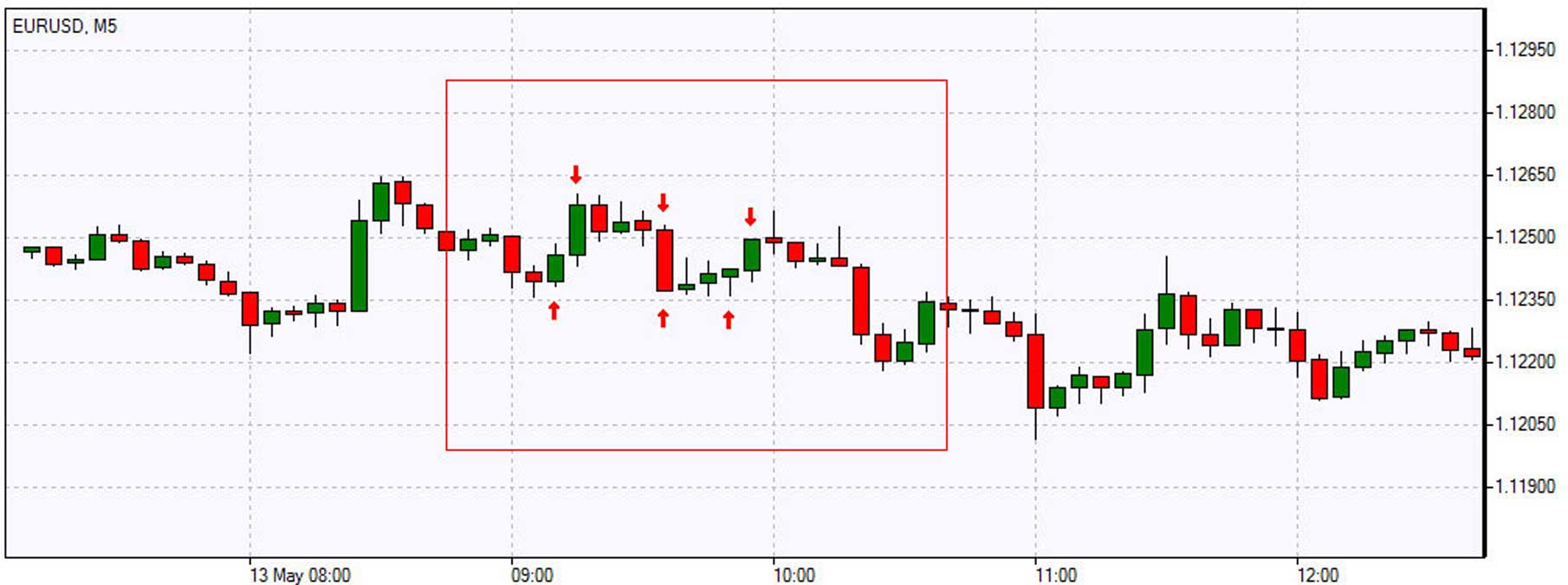8 Tips for Scalping Trading Strategy
Learn 8 practical tips to improve your scalping trading strategy and make faster, smarter trades.

Struggling with market volatility and fast-moving charts? Scalping trading might be the strategy for you. It’s a vital component of Smart Money Trading, focusing on quick trades to capitalize on small market shifts and generate profits. Whether you're aiming to grow your capital or enhance your trading skills, understanding scalping can be beneficial. This guide breaks down the strategy to help you maximize your trading potential.
Aqua Funded’s funded trading program is a great resource to help you do just that.
How Does Scalping Work

Scalping is all about speed and precision. This trading strategy involves rapidly buying and selling securities to capitalize on small price changes. Traders, often using advanced technology, perform these high-volume trades multiple times a day. The goal? Snag quick profits from minor price fluctuations before they disappear.
How Scalping Works: Making the Most of Market Movements
Scalping thrives on predictability. Traders seek events, such as earnings reports, that trigger sudden price fluctuations. They focus on this initial movement, rather than the long-term outcome. Instead of searching for massive wins, scalpers aim to accumulate small, consistent gains, building up their returns incrementally.
Ready to turn your trading skills into profits without risking your capital? AquaFunded’s funded trading program offers accounts of up to $ 400,000, with flexible trading conditions and a profit split of up to 100%. Join over 42,000 traders who’ve already collected more than $2.9 million in rewards.
Related Reading
- How Much Money Do You Need to Start Trading
- How Long Does It Take to Learn Trading
- What Challenges Do Traders Face?
- Futures vs Stocks Trading
- Why is Trading So Hard
- How to Swing Trade
- How to Multiply Your Money
- How to Start Trading With No Money
Benefits and Risks of the Scalping Trading Strategy

Benefits of Scalping: Racing Against the Clock
1. Seizing Quick Profits
In trading, speed is crucial. Scalping thrives on it, aiming to capitalize on brief price shifts for quick gains. By making multiple trades quickly, you can profit from even the most minor price changes and potentially build significant earnings over time.
2. Minimal Market Risk
Scalping keeps your market exposure brief. Unlike longer-term strategies, where conditions can drastically change, scalpers target short-lived market inefficiencies. This approach means you're less vulnerable to sudden market upheavals or overnight changes.
3. Sharpening Focus and Discipline
Scalping needs sharp focus and discipline. You must quickly analyze indicators, execute trades, and manage risk. This constant activity can sharpen your decision-making and foster a disciplined trading mindset.
4. Adaptable Capital Management
Scalping lets you adjust your approach based on market conditions and available capital. By regularly reinvesting profits, you can increase your potential returns.
5. Broad Market Applicability
Scalping isn't limited to specific markets. Whether you're trading Forex, cryptocurrencies, stocks, or commodities, the principles of scalping can be universally applied.
Scalping Risks: The Other Side of the Coin
1. High Transaction Costs
Frequent trades mean higher transaction costs. These can include spreads and commissions that eat into your profits, making it harder to maintain consistent gains. You must carefully weigh potential profits against these costs.
2. Demanding Time and Effort
Scalping requires your full attention as you monitor market movements. This constant pressure can lead to burnout and impact your overall trading performance.
3. Slippage Challenges
Slippage occurs when there's a difference between the expected and actual executed price. In volatile markets, rapid price changes can lead to trades being executed at worse prices than anticipated, potentially hurting profits.
4. Over-Trading Temptation
Scalping's focus on small profits within short periods might tempt traders to open too many positions in a single day. This can increase the risk of over-trading and lead to significant losses.
5. Dependency on Speed
Scalping success relies on fast order execution. If your trading platform or internet connection is slow, you risk missing out on opportunities and potentially reducing your potential profits. The right tools can make a difference here.
Looking to leverage your trading expertise without risking your capital? AquaFunded’s funded trading program offers access to accounts of up to $ 400,000 with flexible conditions, including no time limits and up to 100% profit splits. Join over 42,000 traders who have already earned more than $2.9 million in rewards.
8 Tips for Scalping Trading Strategy

1. Maximize Your Trading Skills with AquaFunded
Why risk your capital when you can leverage AquaFunded? This platform allows you to unlock accounts of up to $400,000, featuring the most flexible trading conditions available, with no time limits, simple profit targets, and a generous profit split of up to 100%. With over 42,000 traders globally already collecting more than $2.9 million in rewards, AquaFunded offers a 48-hour payment promise. Choose between instant funding or customizable challenges to prove your skills, and keep everything you earn. It’s a smart way to turn your trading skills into substantial profits.
2. Mastering Technical Analysis for Scalping
For scalpers, technical analysis is your bread and butter. Moving averages, the Relative Strength Index (RSI), and support and resistance levels are your go-to tools for analysis. These tools help you pinpoint optimal entry and exit points. Keep an eye out for breakouts or reversals, and act quickly once the market confirms your analysis. The more you practice, the better you’ll get at spotting these opportunities.
3. Effective Risk Management in Scalping
In scalping, even small mistakes can add up. Use stop-loss orders to limit potential losses and maintain small position sizes. This approach ensures that no single trade can wipe out your gains. Since you’re making numerous trades in a short period, this strategy will help you stay in the game longer.
4. The Power of Price Action in Scalping
Sometimes the best trades come from simply observing price action. Watch for small price changes that signal momentum, and act decisively. With practice, you’ll develop an instinct for spotting profitable opportunities. The more you focus on price action, the better you’ll become at identifying these setups.
5. Pitfalls to Avoid in Scalping
Overtrading, ignoring volume, and chasing trades are common pitfalls in scalping. Stick to high-probability setups, prioritize high liquidity setups, and let missed trades go. Chasing trades often leads to poor decision-making and increased risk. By avoiding these pitfalls, you can enhance your scalping strategy and increase your chances of success.
6. Focus on Mastering One Market
Whether you’re trading forex or individual stocks, it’s wise to master one asset before branching out. This focus allows you to develop a deeper understanding of the asset’s behavior and improve your trading strategy. Once you’ve mastered one market, you can then expand to others with more confidence.
7. Utilizing Scanners for Real-Time Insights
High-of-day scanners can help you identify promising setups in real time. By utilizing these tools, you can stay ahead of market movements and respond promptly to profitable opportunities. Scanners are a valuable resource for scalpers seeking to optimize their trading efficiency.
8. Staying Disciplined in High-Risk Scalping
Scalping is a high-risk strategy that requires discipline to succeed. Stick to your plan and avoid emotional trading. By staying disciplined, you’ll improve your scalping strategy and increase your chances of long-term success.
Top 7 Scalping Strategies for Success

1. Master the Moving Average Ribbon Entry Strategy
To spot robust trends and anticipate shifts in market momentum, apply a five-eight-thirteen simple moving average (SMA) combination on a two-minute chart. This setup helps you identify trends for buying or short-selling during counter swings. When the five-eight-thirteen ribbon aligns and points higher or lower, strong trends are present. Price stays close to the five or eight-bar SMAs. If the price penetrates the 13-bar SMA, it signals waning momentum, suggesting a range or reversal. The ribbon may flatten and crisscross the price. Monitor for realignment by observing ribbons that turn higher or lower, signaling a potential buy or short-sell opportunity.
2. Perfect Your Exit with Relative Strength/Weakness
Timing exits is crucial in scalping. Use five-three-three stochastics and a 13-bar, three-standard-deviation Bollinger Band with ribbon signals on two-minute charts. The best trades occur when stochastics turn higher from oversold or lower from overbought levels. Exit promptly if the indicator crosses and rolls against your position after a profitable move.
Watch how the band interacts with the price to time your exit. Take profit during band penetrations as they predict slowing or reversing trends. Promptly exit if a price thrust fails to reach the band, but stochastics roll over. Adjust the standard deviation of the Bollinger Bands based on daily volatility, if needed, for more signals.
3. Harness the Power of Momentum Scalping
Momentum scalping utilizes indicators such as the RSI and MACD to pinpoint and execute trades in the market's direction quickly. Applied to short timeframes, such as one- or five-minute charts, this strategy identifies strong momentum surges for swift entry and exit points. Buy signals occur when a MACD crossover happens with the RSI above 50 or when the RSI moves out of oversold territory with the MACD line above the signal line.
Sell signals occur when the MACD crosses under the signal line and the RSI falls below 50. Exits for long positions occur when the MACD crosses below the signal line or the RSI exits overbought conditions. Exit short positions when the MACD crosses above the signal line or RSI rises above oversold territory.
4. Leverage Pivot Points for Quick Moves
Pivot points in day trading help quickly identify support and resistance levels for trades. Buy when the price touches a pivot point and shows signs of reversal, then sell near the resistance level. Short near resistance and buy near support. The pivot point reversal strategy enhances this by detecting highs and lows using surrounding bars.
For scalping, when a pivot low is detected, prepare to enter a long position as the price rises above the pivot, allowing you to ride short-term upward momentum. Similarly, when a pivot high forms, prepare to short, triggering the trade if the price drops below the pivot level. This approach maximizes gains from rapid reversals and short-term trends.
5. RMI Trend Sync Strategy: A Powerful Scalping Tool
The RMI Trend Sync strategy uses the Relative Momentum Index (RMI) and the SuperTrend indicator to identify momentum shifts and trend reversals. The RMI detects overbought and oversold conditions, signaling potential momentum changes, while the SuperTrend adapts to market volatility, indicating the direction of the trend. Buy signals occur when the RMI crosses above an oversold threshold and the price is above the SuperTrend line, indicating a confirmed uptrend.
Conversely, sell signals occur when the RMI crosses below the overbought threshold and the price is below the SuperTrend line, confirming a downtrend. Exits occur when the RMI indicates a momentum reversal or when the price crosses the SuperTrend line, indicating a trend change.
6. Predictive Linear Regression Channels Strategy
This strategy uses linear regression channels with Bollinger Bands to identify buy and sell opportunities, aligning with the prevailing trend. Buy when the price touches or nears the lower Bollinger Band, signaling oversold conditions. Sell when the price approaches the upper Bollinger Band, indicating overbought conditions, only when the linear regression slope points downward, signaling bearish momentum.
This works well in range-bound markets where prices oscillate within a predictable channel. It allows traders to enter and exit trades at Bollinger Band extremes for quick profits. Even in trending markets, it aligns traders with broader trends while capitalizing on minor pullbacks or rallies.
7. EMA Crossover with RSI Filter: A Winning Combo
The EMA Crossover with RSI Filter strategy combines the exponential moving average (EMA) and RSI to capture short-term price moves in trending markets. Buy when the closing price is above the fast-EMA, the fast-EMA is above the slow-EMA, and the RSI crosses above oversold levels. Sell when the closing price is below the fast-EMA, the fast-EMA is below the slow-EMA, and the RSI crosses below overbought levels.
Enter long trades during slight pullbacks in an uptrend and short trades during brief spikes in a downtrend. This method is ideal for capturing quick moves while limiting downside risk. The EMA crossovers ensure trading with the trend, while the RSI helps avoid entering too late by signaling overbought or oversold conditions.
Looking to leverage your trading expertise without risking your capital? AquaFunded’s funded trading program offers access to accounts of up to $ 400,000 with flexible conditions, including no time limits and up to 100% profit splits. Join over 42,000 traders who have already earned more than $2.9 million in rewards.
Related Reading
- What Happens if You Blow a Funded Account
- How to Become a Professional Trader
- Best Market to Trade for Beginners
- Tips for Day Trading
- Common Trading Mistakes
- Margin vs Leverage
- How Much Can You Make Day Trading With 100k
- Margin vs Leverage
- Day Trading vs Options
- Best Time Frame for Day Trading
Join Our Funded Trading Program Today - Trade with our Capital and Keep up to 100% of the Profit.

Feeling the pulse of market fluctuations and making quick decisions is an art. AquaFunded turns this art into a rewarding experience. They offer access to accounts up to $400,000, allowing you to build wealth without jeopardizing your own money. Think of it as pushing a high-performance vehicle to its limits without worrying about a crash.
AquaFunded's platform offers the most flexible trading conditions available, including no time limits and easily attainable profit targets. They've already paid over $2.9 million to traders, and they’re ready to back you with a 48-hour payment guarantee. Whether you go for instant funding or a customizable challenge path, AquaFunded makes it easy to keep up to 100% of your earnings.
Related Reading
- Why Do Most Day Traders Fail
- Is Day Trading Profitable
- How to Take Profits in Trading
- Fair Value Gap Trading
- Best Time of Day to Trade Stocks
- How to Make Money Online Trading
- Prop Firms With No Time Limit
- Different Stock Trading Strategies
- Swing Trading Prop Firms
- Best Technical Indicators for Day Trading


